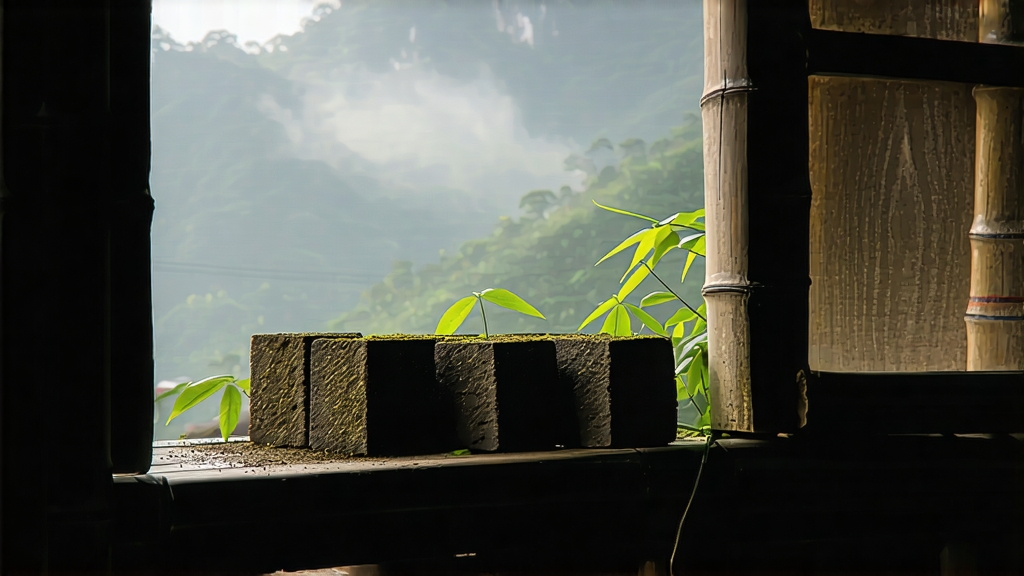
Tucked away in the subtropical hills of Guangxi Province, Liu Bao (literally “Six Forts”) is the quiet genius of China’s dark-tea family. While Pu-erh hoards the global spotlight, Liu Bao has spent four centuries refining a flavor that Chinese tea hunters describe as “old betel-nut meeting rainforest earth after rain.” To understand it is to witness how geography, trade routes, and microbial artistry can turn a simple leaf into a time-release symphony.
-
From Ming Militias to Maritime Silk Road
The name Liu Bao refers to the six defensive outposts established around Wuzhou during the Ming dynasty. Tea grown in these high-humidity valleys was compressed into 40 kg bamboo baskets, carried by porters to the Xun River, then loaded onto junks bound for Hong Kong and, ultimately, Southeast Asia. By the late 17th century, Liu Bao was the breakfast drink of tin miners in Kuala Lumpur and the secret ingredient in Hainanese kopi “tea-coffee” blends. Ship manifests from 1888 list Liu Bao alongside opium and gambier, proof that the tea was currency in everything from labor wages to dowries. -
One Leaf, Three Faces
Modern Liu Bao is classified by both harvest grade and aging vessel.- Special Grade (gong ting): buds only, velvet texture, orchid-betel top note.
- First Grade (yi ji): one bud plus first leaf, balances sweetness and bark-like depth.
- Third Grade (san ji): larger leaves, higher microbial load, favored by Malaysian collectors for “old taste” (lao wei).
Aging vessels add a second axis: bamboo basket (tong) encourages slow respiration and betel-nut aroma; clay jar (cun) softens edges and adds plum notes; compressed brick (zhuan) accelerates fermentation, yielding a camphor finish within five years.
-
The Craft: Where Smoke Meets Microbes
Unlike Pu-erh’s sun-dried maocha, Liu Bao starts with a 30-second “kill-green” at 280 °C that locks in a subtle smokiness. The pivotal step is “wet piling” (wo dui): leaves are sprayed with mountain spring water, stacked 70 cm high, and covered with jute sacks. Indigenous microbes—Bacillus subtilis, Aspergillus niger, and a rare yeast Pichia fermentans—feast for 20–35 days while internal temperature hovers at 55 °C. Masters “read” the pile by smell: a shift from wet hay to dried longan signals the end. After piling, the tea is steamed, packed into bamboo-lined baskets, and stored in riverside caves where humidity stays above 85 %. There, slow oxidation and secondary fermentation create the signature “red soup, amber bottom” (hong tang jin di). -
Brewing Liu Bao: A Ritual of Patience
Western brewers often treat dark tea like black tea—boiling water, five minutes, done. Liu Bao rebels. Start by rinsing 5 g of leaf in a 150 ml Yixing pot for five seconds; discard the rinse to wake the microbes. First steep: 95 °C water, 15 s. The liquor glows like antique cherry wood and smells of rain-soaked pine. Second steep: 20 s, betel nut and dark honey emerge. By the fifth infusion, add 10 s each time; the tea will surrender cocoa and orchid. A 1998 basket can yield 15 stellar brews before it sighs into sweet water. For grandpa-style travel brewing, drop 3 g into a thermos of 90 °C water; three hours later you have a smoky, molasses-thick drink that survives refills all day. -
Tasting Notes: A Lexicon for the Uninitiated
Liu Bao’s flavor wheel is tiny but intense. Look for:- Betel nut: a peppery buzz on the tip of the tongue, borrowed from Areca catechu chewed across Southeast Asia.
- Wet cave: the scent of limestone and moss, a terroir note impossible to replicate outside Guangxi.
- Red dates: appears in teas aged 8–12 years, when melanoidins from Maillard reactions peak.
- Camphor: a cooling finish in 20-year-plus examples, caused by microbial conversion of cineole.
Professional cuppers score Liu Bao on